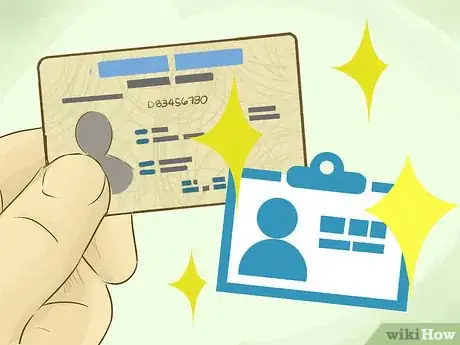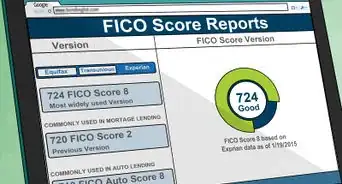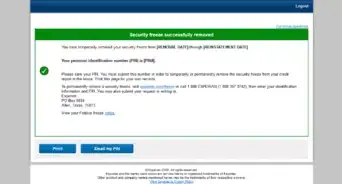This article was co-authored by Michael R. Lewis. Michael R. Lewis is a retired corporate executive, entrepreneur, and investment advisor in Texas. He has over 40 years of experience in business and finance, including as a Vice President for Blue Cross Blue Shield of Texas. He has a BBA in Industrial Management from the University of Texas at Austin.
wikiHow marks an article as reader-approved once it receives enough positive feedback. In this case, 86% of readers who voted found the article helpful, earning it our reader-approved status.
This article has been viewed 153,111 times.
If your legal name changes because of a marriage, divorce or other court order, it is wise to contact the credit bureaus directly to notify them of the change. When you update your name with your creditors, they will automatically notify the credit reporting agencies. But this can take a lot of time, sometimes up to six months or more. This could delay any loan application process or other credit history review. Instead, be proactive and notify the credit reporting agencies yourself of your name change.
Steps
Notifying the Credit Reporting Agencies
-
1Contact all 3 credit bureaus with your updated information. When you change your name with your creditors and with Social Security, the credit agencies should be automatically notified of the change. However, it’s still a good idea to send them a letter informing them of the change.[1]
- Send your information to Equifax at P.O. Box 740256, Atlanta, GA 30374
- Get in touch with TransUnion LLC P.O. Box 2000, Chester, PA 19022
- Let Experian know about your name change. Send information to National Consumer Assistance Center, P.O. Box 2002, Allen, TX 75013.
-
2Include relevant information in the letter. The credit reporting agencies will need specific documentation in order to process your name change. In addition to your previous and new names, they will need your contact information and legal verification of your name change.[2]
- Tell them your name. In your letter, let the agency know your full previous full name as well as your new full name.
- Inform them of a new address. If your address has changed, let the agency know both your old and new legal address.
- Include your social security number on the letter. To make sure they are changing the information for the correct person, include your social security number on the letter. This number separates you from any other person out there with your same name.
- Enclose proof of your legal name change. Provide in your envelope any legal documentation you have concerning your name change. This documentation may include a marriage license, official divorce papers or other court order.
Advertisement -
3Get your credit report. Obtain a copy of your credit report as a follow up to your name change request with the credit bureaus. According to the Fair Credit Reporting Act (FCRA), you are entitled to receive a free credit report once every 12 months. You can also purchase a copy of your credit report from the credit reporting agencies.[3] .
- Visit AnnualCreditReport.com or call 1-877-322-8228. You can also download the Annual Credit Report Request Form and mail it to Annual Credit Report Request Service, P.O. Box 105281, Atlanta, GA 30348-5281.
- If you have already received your free credit report within the past 12 months, you can purchase a copy from Equifax for $39.95. This includes your credit history from all three credit reporting agencies and your FICO score.[4]
- You can purchase a credit report from one of the credit reporting agencies for $19.95 from myFICO.[5]
-
4Understand how a name change affects your credit history. Changing your name should not change your credit history. Your credit should just continue to build in your new name. Your old and new names should be included on your credit report.
- When your last name changes after a marriage or divorce, your credit reports automatically update after you notify your creditors of your new name. As creditors update their records, they send the changes to the credit reporting agencies.
- If you change your whole name, it is possible that creditors will have trouble verifying your credit history. This is because credit reporting agencies identify you not just with your Social Security number, but also with your date of birth and current and previous mailing addresses. When applying for credit under your new name, be sure to provide full and complete identifying information so the credit reporting agencies can link you to your credit history.
Notifying Creditors of Name Change
-
1Get a new Social Security card. Do this first because you can use it to officially change your name on other forms of identification. Only your name will change, not your social security number. You will need to include proof of your age, identity, and U.S. citizenship or immigration status.[6]
- Download the Application for a New Social Security Card from the Social Security Administration.
- Provide proof of your age, such as your birth certificate, a U.S. hospital record of your birth (created at the time of birth), a religious record established before age five showing your age or date of birth, your passport, or a final adoption decree (the adoption decree must show that the birth information was taken from the original.
- Include proof of identity, such as a U.S. driver's license, a U.S. State-issued non-driver identity card or a U.S. passport.
- Include evidence of U.S. citizenship, such as a U.S. birth certificate, a U.S. Passport, a consular report of birth, a certificate of citizenship or a certificate of naturalization.
- If you are not a U.S. citizen, include an unexpired document issued to you by the Department of Homeland Security (DHS) showing your immigration status, such as Form I-551, I-94, or I-766. International students or exchange visitors must also submit Form I-20, DS-2019 or a letter from their school or employer authorizing their employment (F-1) or sponsorship (J-1).
-
2Change your name on your driver’s license. Once you have your new Social Security card, you can use it to change your name on your driver’s license. Visit the website of your states Department of Motor Vehicles to learn the process for changing your name on your driver’s license. You will likely need to bring your social security card, your old driver’s license, your birth certificate, and legal verification of your name change, such as a marriage license, official divorce papers or other court order.
-
3Change your name with your employer. Your employer’s human resources department will assist you with changing your name on your work documents. You need to do this so that your paychecks and pay stubs reflect your new name. Other work documents, such as your life insurance and retirement plan documents, should also be updated with your new name.
-
4Update your name on your financial accounts. Notify all of your banks and creditors of your new name. When you notify your creditors of your new name, they will automatically notify the credit bureaus. Your credit history under your old name will not be erased or changed. Rather, your credit will just continue to build under your new name.
- To update your name on your bank accounts, you may need to visit your bank in person. Bring your social security number, driver’s license or passport, and legal verification of your name change, such as a marriage license, divorce decree or court order. Change you name on your credit cards, debit cards and checks. If your name has changed because you got married or divorced, you may need to add or remove a spouse from ownership on your accounts.
- Notify other creditors of your name change, including issuers of a car loan, line of credit, mortgage, credit cards and other credit accounts.
Fixing Errors on Your Credit Report
-
1Contact the credit bureau. If you receive your credit report and you find that your name is incorrectly reported, contact them right away. Send a letter by certified mail, return receipt requested so that you can track it. Include copies of all of your supporting documents, including your identification, Social Security card and legal verification of your name change.[7]
- Send the letter to Equifax at Equifax Information Services, LLC, P.O. Box 740256, Atlanta, GA 30374.
- Send the letter to TransUnion at P.O. Box 2000, Chester, PA 19022-2000.
- Send the letter to Experian at P.O. Box 2002, Allen, TX 75013.
-
2Contact the agency that reporting the inaccurate information. If you have any inaccuracy on your credit report, contact the creditor or other agency who reported the incorrect information. Work with them to update their documentation to accurately reflect your new legal name. Notify them that you have contacted the credit bureaus to report the inaccuracy.[8]
References
- ↑ http://www.bankrate.com/brm/news/financial_literacy/pdf/june07_work_sheet_name_change_a1.pdf
- ↑ http://www.bankrate.com/brm/news/financial_literacy/pdf/june07_work_sheet_name_change_a1.pdf
- ↑ http://www.consumer.ftc.gov/articles/0155-free-credit-reports
- ↑ http://www.equifax.com/3in1-credit-report-score/
- ↑ http://www.myfico.com/
- ↑ http://www.socialsecurity.gov/forms/ss-5.pdf
- ↑ http://www.myfico.com/crediteducation/rights/fixinganerror.aspx
- ↑ http://www.myfico.com/crediteducation/rights/fixinganerror.aspx
About This Article
If you've recently changed your name, you actually don't need to inform the credit bureaus, since it will update automatically when you change your name with your creditors. To change your name with your credits, start by getting a new Social Security card, as you will need this to be able to change your names on other official documents. To get a new Social Security card, complete an application form and submit it alongside proof of your age, identity, and citizenship. Then, change your name on your driver’s license, using your new Social Security card and your old driver's license. Finally, change your name with your employer and any banks that you use. For more information from our Financial co-author, like how to fix errors on your credit report, read on.





































































